This post may contain affiliate links. If you click through a link and make a purchase, I may receive a commission at no additional cost to you. As an Amazon Associate, I earn from qualifying purchases. Read the full disclosure here.
Most people remember kinesiology tape from the 2008 or 2012 summer Olympics.
Athletes of all sports, from volleyball to swimming, could be seen sporting colorful tape applied in crazy patterns.
But how does kinesiology taping work?
Stick around to find out, plus plenty of pro tips to help your tape actually stay on.
Disclaimer: This content is for educational purposes and is not medical advice. Read the full disclaimer.
What is kinesiology tape?
Kinesiology tape is a style of therapeutic tape made with flexible elastic to allow the tape to move with you rather than restrict movement.
The material of most brands is constructed from a breathable fabric with a medical-grade adhesive to allow the tape to stay on for several days.
The original kinesiology tape is the Kinesio Tape brand, invented by Dr. Kenzo Kase in the 1970s.
I got certified as a Kinesio taping practitioner back in 2009 when taping was all the rage.
Since then, many other brands of kinesiology tape have hit the market, such as Rock Tape, KT Tape, Theraband Kinesiology Tape, and Spider Tech. Each has its own secret sauce spin on therapeutic tape.
Just to distinguish, the term “kinesiology tape” is the umbrella term for this type of taping. “Kinesio tape” is a brand and not just an abbreviation for the word kinesiology.
My top two favorite brands are Kinesio Tape and Rock Tape because they seem to stay on the best, in my experience.
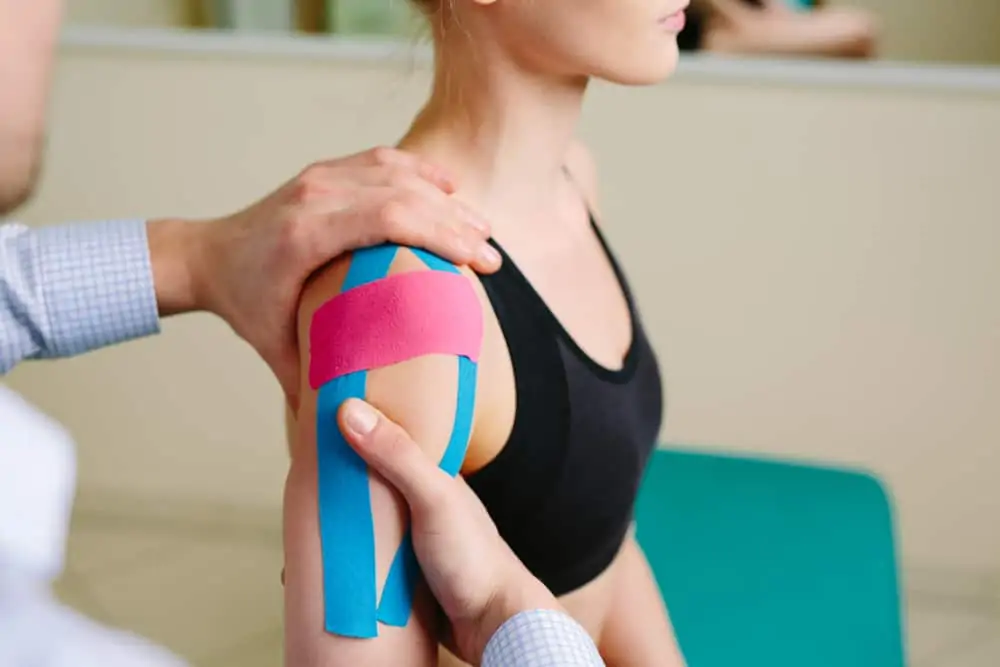
What is kinesiology tape used for?
Kinesiology tape has a wide variety of uses, some more scientifically backed than others (which I’ll get into in the next section).
Some reasons for using kinesiology tape are:
- To support a weak area
- Improve proprioceptive input
- Re-educate muscles for healthy movement patterns
- Scar management
- Improve circulation
- Decrease swelling
- Decrease bruising
- Improve athletic performance*
Does kinesiology tape work?
The classic answer to a non-specific question – it depends.
Some claims sound great in theory but don’t necessarily pan out in the real world.
The overall effectiveness of kinesiology tape is still being studied and some of the available research does have limitations.
There’s likely a heavy placebo component at play, which I’m not against, but it’s important to know what tape can and can’t do.
Kinesiology tape helps decrease pain by providing proprioceptive input to the skin.
Decreasing pain may help improve movement patterns, reduce compensatory motions, and improve tolerance to rehab exercises or daily activities.
I most commonly tape patellofemoral pain (knee cap pain), plantar fasciitis, Achilles tendinitis, shoulder tendinitis, tennis elbow, and lumbar muscle spasms.
I’ve also had good results applying tape to improve scar tissue mobility.
Ozturk G et al. studied patients with myofascial pain syndrome and the effect of Kinesio taping on pain. The study concluded that patients demonstrated a significant improvement in pain and upper trap muscle strength with the application of Kinesio tape.
Studies show that kinesiology taping is most effective when combined with other treatments.
Kinesiology tape claims to be good for swelling; however, several studies (Hormann J et al. and Nunes GS et al.) showed no significant difference in post-op swelling or acute lateral ankle sprains.
As far as using kinesiology tape to improve athletic performance, evidence is also lacking.
There’s isn’t evidence that tape improves performance, bure also isn’t evidence that it negatively affects performance.
It’s neither here nor there, but probably has a mental component for athletes.
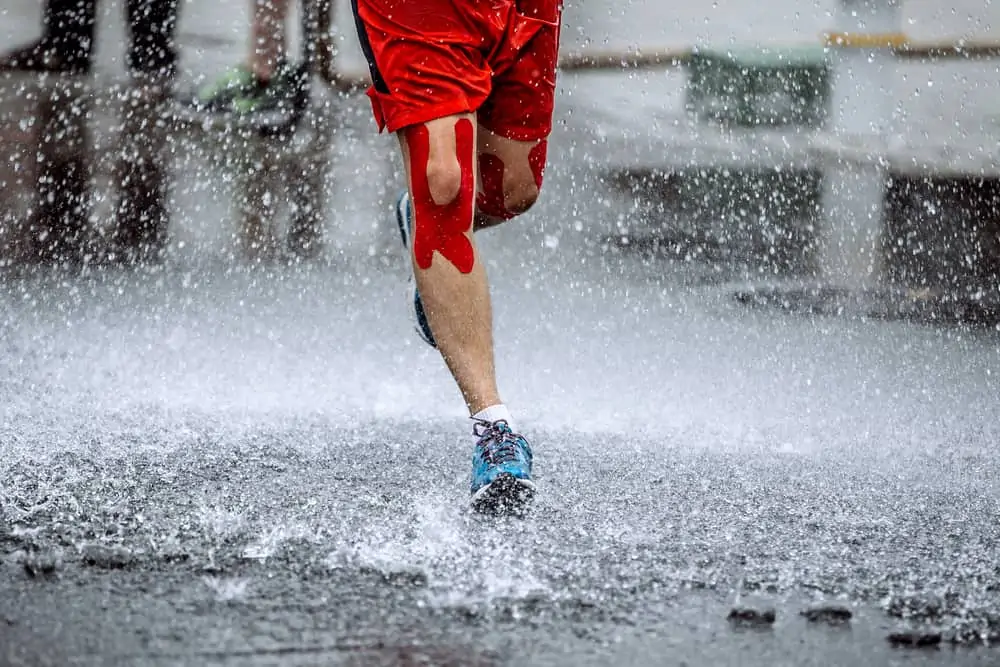
What taping can’t do
Sorry to burst your bubble, but taping isn’t a magical band-aid.
Before you Google “will tape fix my (fill in the blank),” you need to know that tape alone isn’t going to fix an injury or correct underlying movement dysfunctions.
Taping works best when combined with other appropriate treatments.
It also shouldn’t be used for the long term to hold you together while you continue the same bad habits.
Tape is meant to help you through a particular phase of your rehab. It’s not meant to be a lifelong treatment.
If taping decreases pain, then you also need to be careful not to overdo it. Activity modification is essential in the healing process.
You can’t just slap kinesiology tape on and call it a day. If that’s the case, your symptoms can actually get worse.
It’s important to actually fix your injury and not simply apply a colorful band-aid.
Pro tips for taping
After years of taping and a certification, here are all my pro tips for using kinesiology tape effectively.
Clean your skin well
I have a reputation with patients for my tape staying on really well. That’s because I don’t skimp on the cleaning phase.
If there are any oils, lotions, or sweat, the tape may not stick well or peel soon after application.
Wash the area with soap and water, then wipe clean with alcohol to remove all oils and dirt.
If you’re in the middle of a workout, you’ll need to stop sweating before applying the tape, otherwise, it won’t stick.
Let the skin dry thoroughly for a few minutes before applying the tape.
Trim the area if there’s a lot of hair
Long or thick hair will limit how well the tape sticks to the skin.
This is typically a guy problem when taping arms, legs, or backs.
Use baby oil or olive oil to remove the tape
Kinesiology tape adhesive is strong because it’s intended to stay on for several days.
If you need to remove the tape DO NOT RIP THE TAPE OFF! You can actually rip off some skin with it.
Saturate the top of the tape with baby or olive oil and wait a few minutes. This helps to loosen the adhesive from your skin and allows you to gently peel the tape off.
You can also purchase tape remover pads.
Don’t tape over skin irritation
Taping over irritation will make irritation worse and is not advised.
This includes cuts, scrapes, sunburns, etc.
Contraindications and precautions for kinesiology taping
Kinesiology tape is not appropriate for the following conditions:
- Certain types of cancers
- Over open wounds, skin irritation, infections
- Diabetes or kidney problems
- Allergy to adhesive
- Presence of DVT or blood clots
- Over areas of decreased sensation or numbness
- Thin skin (particularly in elderly people)
- Congestive heart failure
If you’re not sure if taping is right for you, speak with a physical therapist or other healthcare worker trained in kinesiology taping.
Cut the corners of the tape to round the edges
Rounding the edges of the tape helps them not to peel.
Don’t use tension on the ends (tails) of the tape
The tape will begin to peel almost immediately if you pull any tension on the ends (aka tails) of the tape.
Make sure to stick the tape down to the skin before pulling any tension and stop pulling before sticking the end down.
Understand WHY you’re taping
Taping for the wrong reasons or using improper techniques can actually make your symptoms worse.
At best, it will be a total waste of time (and expensive tape).
If you’re not sure how or why to tape, discuss with a physical therapist or chiropractor who’s trained in kinesiology taping.
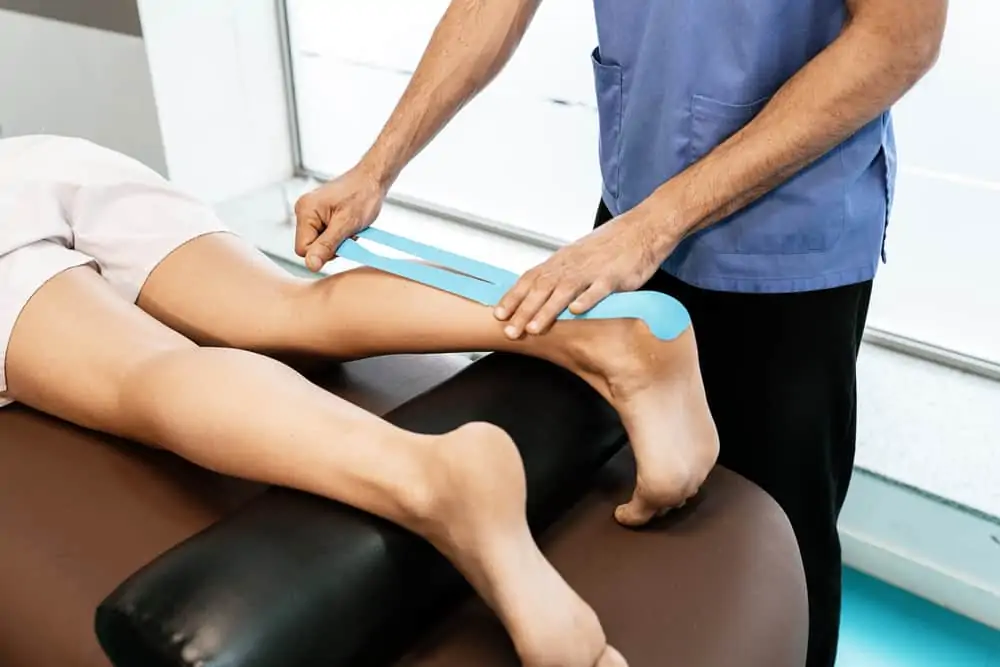
Other FAQ about kinesiology tape
Can kinesiology tape hurt you?
Kinesiology tape can cause skin irritation, especially for sensitive skin.
If you’re sensitive to adhesives, try a small test patch for a few hours and see how your skin reacts.
Irritation can also occur with too much taping over one area, removing the tape improperly, or if the tape isn’t changed in a timely manner and has been exposed to water/sweat, etc.
There’s also the chance that taping can make symptoms worse if it’s applied incorrectly (for example using too much tension or the wrong type of technique).
Can you apply kinesiology tape to yourself?
Yes, it is possible to tape yourself for some areas.
Areas on the backside of the body are more difficult or impossible to tape yourself. A family member can also be trained to tape you.
Always make sure you understand the technique and precautions or contraindications.
How long can you leave kinesiology tape on?
In the real world, I’ve found 2-3 days is the max, especially for active people.
After a few days, the tape starts to peel and get pretty funky. At this point, it’s a good idea to give the skin a breather.
If a small portion of tape has peeled, it can be trimmed off, but can’t be reapplied.
If there’s no irritation, you can apply new tape right away after a thorough cleaning.
Where can I buy kinesiology tape?
Kinesio Tape, Rock Tape, Theraband Kinesiology Tape, KT Tape, and Spider Tech are all available on Amazon.
You can also find tape at sporting goods stores, some medical supply stores, or the individual manufacturers’ websites.
My favorite two brands are Kinesio and Rock Tape because I feel they stay on the best.
What’s the difference between all the colors of tape?
Usually, nothing unless otherwise specified. Feel free to get whatever color or design fits your style.
What’s the difference between pre-cut strips and the roll of tape?
Some taping techniques require you to cut the tape into various styles. Pre-cut strips are ready-made for certain taping techniques.
Personally, I don’t use pre-cut strips as the full roll gives me all the flexibility I need to create any technique.
Wrapping up
Kinesiology tape can be an effective tool if used correctly and is most beneficial when combined with other treatments.
It’s important to know why you’re taping and how to tape correctly to avoid making your symptoms worse.
Remember, taping isn’t meant to be a long-term fix or compensate for other mechanical problems. Get the root cause of your symptoms addressed instead of trying to put a band-aid on it.
REFERENCES
Drouin JL, McAlpine CT, Primak KA, Kissel J. The effects of kinesiotape on athletic-based performance outcomes in healthy, active individuals: a literature synthesis. J Can Chiropr Assoc. 2013;57(4):356-365.
Hörmann J, Vach W, Jakob M, Seghers S, Saxer F. Kinesiotaping for postoperative oedema – what is the evidence? A systematic review. BMC Sports Sci Med Rehabil. 2020;12:14. Published 2020 Mar 2. doi:10.1186/s13102-020-00162-3
Nunes GS, Vargas VZ, Wageck B, Hauphental DP, da Luz CM, de Noronha M. Kinesio Taping does not decrease swelling in acute, lateral ankle sprain of athletes: a randomised trial. J Physiother. 2015 Jan;61(1):28-33. doi: 10.1016/j.jphys.2014.11.002. Epub 2014 Dec 9. PMID: 25499648.
Öztürk G, Külcü DG, Mesci N, Şilte AD, Aydog E. Efficacy of kinesio tape application on pain and muscle strength in patients with myofascial pain syndrome: a placebo-controlled trial. J Phys Ther Sci. 2016;28(4):1074-1079. doi:10.1589/jpts.28.1074

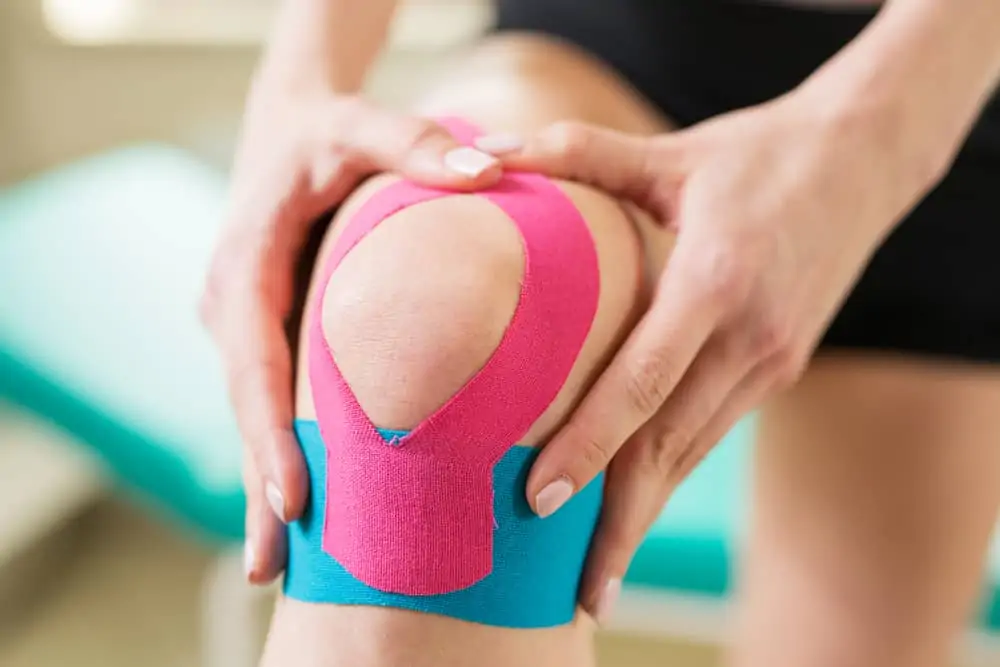
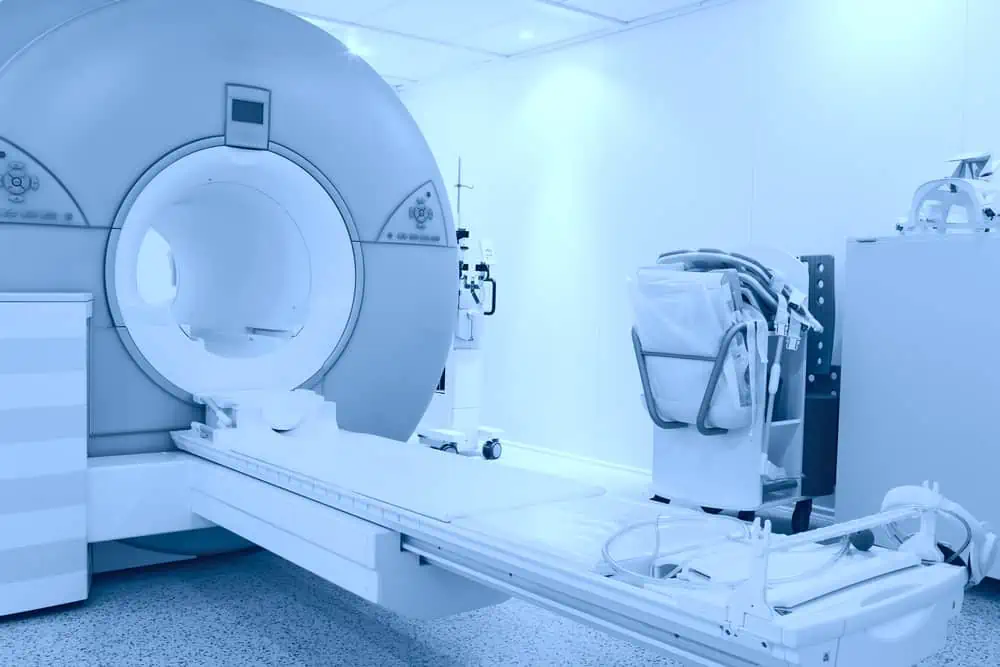

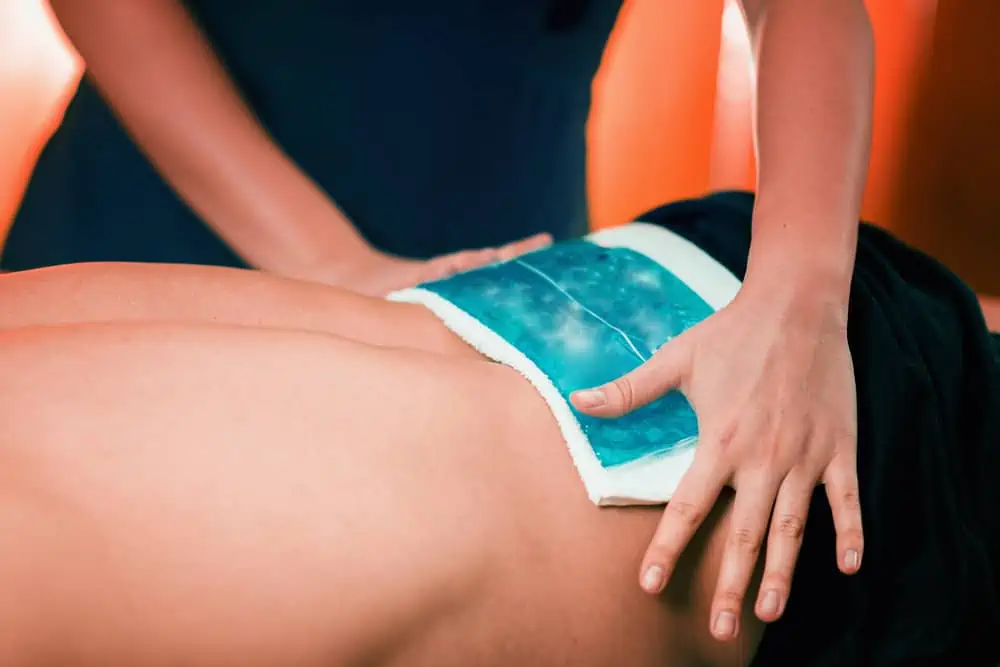
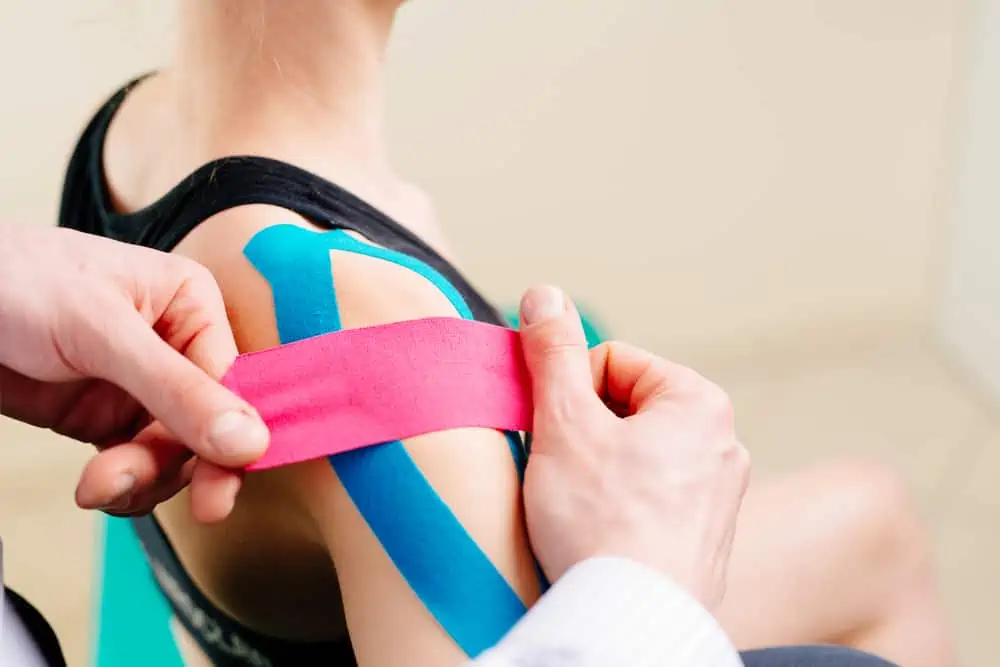

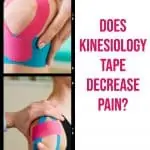
Thorough article. You mentioned use for proprioception. I did not learn whether for upper back slouching (with yoga added) this might help. Can you speak to this please? I know about ergonomic changes to surface heights. Thanks. CoCo
Great info to know more about these tapes and also they are not cheap. Enjoyed all the info here.
Great information about using tapes. I think it makes it worse to tape on body irritations
I keep thinking about trying this, I have a shoulder that likes to act up from time to time.
I had my knee taped when I was going to physical therapy. It felt weird but good at the same time.
This was so informative! I have never needed to use this tape (thankfully!) and have been noticing it on athletes more often. I was curious how it worked and you answered that question perfectly! Thanks!
My physical therapist used kinesiology tape on me last year. It was interesting how it eased the tension and helped with exercises. The scar tissue mobility use is also interesting to learn. I’m going to ask her about that on my knee. Thanks for this great post!